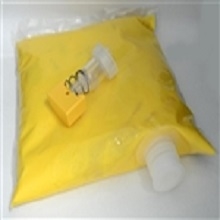A father of two small kids, Martin Galindo-Larios Jr. has tragically died.
A 33 year old mother of three, Lavinia Kelly, is paralyzed, unable to speak or breathe on her own.
The New York Daily news cites, Theresa Kelly recalling her sister calling, unable to express what was wrong with her. “My phone rings and I pick up the phone it’s her and she can’t articulate a word,” she told the news station. “I’ve never seen my sister not have function of her body or not be able to communicate.”

There are at least eight others ill. From one of the scariest foodborne pathogens, C. botulinum. This is a terrible outbreak with a lot of unknowns.
All because of gas station nacho cheese.
The type of cheese comes in a bag, usually inserted into a dispenser that heats it up and holds it until someone pours it on their Doritos. The cheese linked to these illnesses, from Gehl Foods, is produced aseptically to be stored at room temperature. Unrelated, Gehl Foods had a recall on their dispensers a few years ago due to fire risks.
And much of the information that’s out there points to the cheese being the vehicle, but since all the illnesses are linked to one gas station, Valley Oak Food and Fuel gas station in Walnut Grove, California, it’s likely that storage, handling or both led to the illnesses.
Nozzles on food and beverage dispensers are notorious for soil and have been linked to listeria issues in the past. Its possible that buildup or contamination from hands or food placed a spore in the nozzle area – and it got sucked up into the anaerobic cheese bag. This only becomes an issue if the temperature of the cheese in the dispenser drops lower than 120F or so.
 Maybe a food employee took a half empty bag out of the dispenser, and put an old cap back on the bag, and left it out at room temperature for a while (like hours or days) by accident. And then reinstalled it.
Maybe a food employee took a half empty bag out of the dispenser, and put an old cap back on the bag, and left it out at room temperature for a while (like hours or days) by accident. And then reinstalled it.Or possibly there was a puncture of the bag in transport or storage that shoved a spore deep inside the cheese – and the product coagulated and hardened, resealing the package.
I’m done speculating now.
I told Laura Geggei at Live Science about botulism, and why it scares me.
The toxin blocks nerve messages, which, in turn, causes people to lose control of their muscles, Chapman told Live Science. For instance, people who have consumed the toxin may have trouble swallowing, droopy eyelids and difficulty breathing, he said.
“They are essentially paralyzed, as the toxin surrounds those nerves and blocks those messages,” Chapman told Live Science.
“People can recover only as the toxin gets scrubbed from their body, which is a long, horrible process,” Chapman said. “Some people never recover from it. I’ve seen cases of people, years later, still walking with a cane [and] having problems with speech.”
